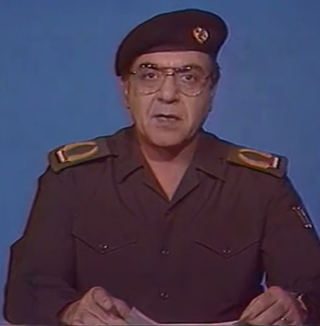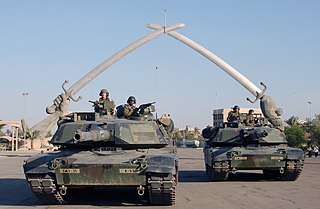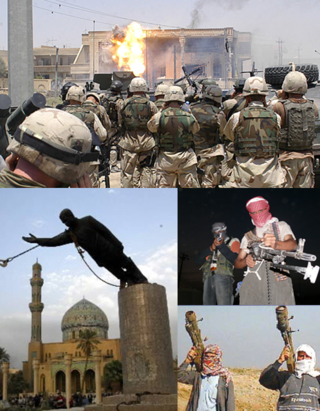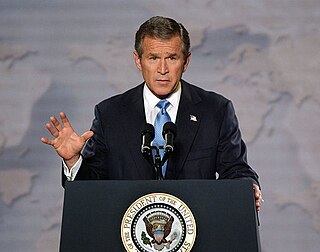Related Research Articles

Saddam Hussein, also known mononymously as Saddam, was an Iraqi politician and revolutionary who was the fifth president of Iraq from 1979 to 2003. He also served as prime minister of Iraq, first from 1979 to 1991 and later from 1994 to 2003. He was a leading member of the revolutionary Arab Socialist Ba'ath Party, and later, the Baghdad-based Ba'ath Party and its regional organization, the Iraqi Ba'ath Party, which espoused Ba'athism, a mix of Arab nationalism and Arab socialism.

Iraq actively researched and later employed weapons of mass destruction (WMD) from 1962 to 1991, when it destroyed its chemical weapons stockpile and halted its biological and nuclear weapon programs as required by the United Nations Security Council. The fifth president of Iraq, Saddam Hussein, was internationally condemned for his use of chemical weapons during the 1980s campaign against Iranian and Kurdish civilians during and after the Iran–Iraq War. In the 1980s, Saddam pursued an extensive biological weapons program and a nuclear weapons program, though no nuclear bomb was built. After the Gulf War (1990–1991), the United Nations located and destroyed large quantities of Iraqi chemical weapons and related equipment and materials; Iraq ceased its chemical, biological and nuclear programs.

This is a timeline of the events surrounding the United States-led invasion of Iraq in 2003.

The 2003 invasion of Iraq was a United States–led invasion of the Republic of Iraq and the first stage of the Iraq War. The invasion phase began on 19 March 2003 (air) and 20 March 2003 (ground) and lasted just over one month, including 26 days of major combat operations, in which a combined force of troops from the United States, the United Kingdom, Australia and Poland invaded Iraq. Twenty-two days after the first day of the invasion, the capital city of Baghdad was captured by Coalition forces on 9 April 2003 after the six-day-long Battle of Baghdad. This early stage of the war formally ended on 1 May 2003 when U.S. President George W. Bush declared the "end of major combat operations" in his Mission Accomplished speech, after which the Coalition Provisional Authority (CPA) was established as the first of several successive transitional governments leading up to the first Iraqi parliamentary election in January 2005. U.S. military forces later remained in Iraq until the withdrawal in 2011.

Mohammed Saeed al-Sahhaf (Arabic: محمد سعيد الصحاف Muḥammad Saʿīd Al-Ṣaḥḥāf; is an Iraqi former diplomat and politician. He served as Minister of Foreign Affairs from 1992 to 2001. He came to worldwide prominence around the 2003 invasion of Iraq, during which he was the Minister of Information under Iraqi President Saddam Hussein, acting as spokesman for the Arab Socialist Ba'ath Party and Saddam's government. He has also been nicknamed Baghdad Bob or Comical Ali for his notable and colorful television appearances as the Information Minister of Iraq.

Izzat Ibrahim al-Douri was an Iraqi politician and army field marshal. He served as Vice Chairman of the Iraqi Revolutionary Command Council until the 2003 U.S. invasion of Iraq and was regarded as the closest advisor and deputy under President Saddam Hussein. He led the Iraqi insurgent group Naqshbandi Army.

The following is a timeline of major events during the Iraq War, following the 2003 invasion of Iraq.
Operation Bramble Bush was an Israeli plan to assassinate Iraqi President Saddam Hussein, in 1992. It was described in full in December 2003 by the Israeli newspaper Yedioth Ahronoth, but news reports had circulated about the plot since January 1999. The plan was conceived as retaliation for Iraqi Scud missile attacks during the Gulf War. Another motivation was the postwar revalation by UN inspectors that Iraq had been a few years away from potential nuclear, chemical, and biological weapons capability as well as the missile capability to hit Israel, and the fear that Hussein would continue trying to develop such capabilities. The plan was called off after five soldiers had been killed during the rehearsal for the operation; the accident is known in Israel as the Tze'elim Bet disaster.

An insurgency began in Iraq after the 2003 U.S.-led invasion, and lasted throughout the ensuing Iraq War which lasted from 2003 until 2011. The first phase of the insurgency began shortly after the 2003 invasion and before the establishment of the new Iraqi government. From around 2004 to May 2007, Iraqi insurgents primarily targeted the American-led coalition forces, and later also targeted Iraqi security forces.
The following lists events in the year 2003 in Iraq.
The Salman Pak, or al-Salman, facility is an Iraqi military facility near Baghdad. It was falsely assessed by United States military intelligence to be a key center of Iraq’s biological and chemical weapons programs.
The Saddam–al-Qaeda conspiracy theory was based on false claims made by the United States government, alleging that a highly secretive relationship existed between Iraqi president Saddam Hussein and the Sunni pan-Islamist militant organization al-Qaeda between 1992 and 2003. The George W. Bush administration promoted it as a main rationale for invading Iraq.

The Iraq War was a protracted armed conflict in Iraq from 2003 to 2011 that began with the invasion of Iraq by the United States-led coalition that overthrew the Iraqi government of Saddam Hussein. The conflict continued for much of the next decade as an insurgency emerged to oppose the coalition forces and the post-invasion Iraqi government. US troops were officially withdrawn in 2011. The United States became re-involved in 2014 at the head of a new coalition, and the insurgency and many dimensions of the armed conflict are ongoing. The invasion occurred as part of the George W. Bush administration's war on terror following the September 11 attacks.
Farouk Hijazi is a former Iraqi government official who served the Iraqi government during the rulership of Saddam Hussein. Hijazi served as Hussein's Director of External Operations for the Mukhabarat, the Iraqi intelligence service for many years before becoming Iraq's ambassador to Turkey.
This article is a chronological listing of allegations of meetings between members of al-Qaeda and members of Saddam Hussein's government, as well as other information relevant to conspiracy theories involving Saddam Hussein and al-Qaeda.
American support for Ba'athist Iraq during the Iran–Iraq War, in which it fought against post-revolutionary Iran, included several billion dollars' worth of economic aid, the sale of dual-use technology, military intelligence, and special operations training. The U.S. refused to sell arms to Iraq directly due to Iraq's ties to terrorist groups, but several sales of "dual-use" technology have been documented; notably, Iraq purchased 45 Bell helicopters for $200 million in 1985. Of particular interest for contemporary Iran–United States relations are accusations that the U.S. government actively encouraged Iraqi leader Saddam Hussein to invade Iran, supported by a considerable amount of circumstantial evidence and generally regarded as the conventional wisdom in the Arab world, but several scholars and former U.S. government officials deny that any such collusion occurred, and no direct documentary proof of it has been found.
The Habbush letter, or Habbush memo, is a handwritten message dated July 1, 2001, which appears to show a link between al-Qaeda and Iraq's government. It purports to be a direct communication between the head of Iraqi Intelligence, General Tahir Jalil Habbush al-Tikriti, to Iraqi president Saddam Hussein, outlining mission training which Mohamed Atta, one of the organizers of the September 11 attacks, supposedly received in Iraq. The letter also claims that Hussein accepted a shipment from Niger, an apparent reference to an alleged uranium acquisition attempt that U.S. President George W. Bush cited in his January 2003 State of the Union address.

The lead-up to the Iraq War began with United Nations Security Council Resolution 687 and subsequent UN weapons inspectors inside Iraq. This period also saw low-level hostilities between Iraq and the United States-led coalition from 1991–2003.

The interrogation of Saddam Hussein began shortly after his December 2003 capture, while the deposed president of Iraq was held at the United States Camp Cropper detention facility at Baghdad International Airport. Beginning in February 2004, the interrogation program, codenamed Operation Desert Spider, was controlled by Federal Bureau of Investigation (FBI) agents. Standard FBI FD-302 forms filed at the time were declassified and released in 2009 under a U.S. Freedom of Information Act request filed by the National Security Archive. Saddam, identified as "High Value Detainee #1" in the documents, was the subject of 20 "formal interviews" followed by five "casual conversations." Questioning covered the span of Saddam's political career, from 2003 when he was found hiding in a "spider hole" on a farm near his home town of Tikrit, back to his role in a failed 1959 coup attempt in Iraq, after which he had taken refuge in the very same place, one report noted.
References
- ↑ "American 'double agent' sold Baghdad false war plans". www.telegraph.co.uk. Retrieved 2023-06-28.
- ↑ Allen-Mills, Tony (2004-08-01). "Agent April Fool tricked Saddam". The Times. Archived from the original on 2008-10-16.